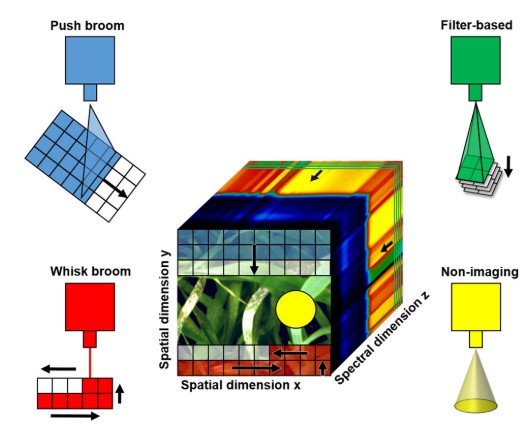Lifeasible is committed to applying various advanced technologies in plant protection and provides services related to hyperspectral imaging technology to help detect and identify plant diseases.
Traditional plant disease detection and quantification are mainly done by visual monitoring, microscopic detection, molecular detection, and microbiological methods. The visual monitoring method is not objective enough. The others are manipulative and time-consuming to operate. Optical sensor-based detection enables non-invasive and objective detection of plant diseases, especially hyperspectral sensors. It can be used for disease detection, identification, and quantification at different scales. There are four main types of hyperspectral sensors (Fig. 1). Combined with appropriate platforms, these four types can enable multi-level plant disease detection, including tissue, leaf, canopy, and field scale.
 Fig. 1 Various types of sensor systems for spectroscopic image acquisition (Thomas et al., 2018).
Fig. 1 Various types of sensor systems for spectroscopic image acquisition (Thomas et al., 2018).
The application of this technique is divided into three steps, image acquisition and pre-processing, data extraction and processing, and data modeling and analysis. We provide the corresponding services based on these three stages.
Image acquisition and pre-processing
At this stage, we will make reasonable hyperspectral image acquisition recommendations based on the needs of the customer's disease detection project, including hyperspectral sensor selection, platform selection, light source selection, exposure time selection, and other acquisition operation recommendations. After acquiring hyperspectral images, we will perform image pre-processing based on the acquisition situation, including calibration and spectral correction.
Data extraction and processing
Each hyperspectral image collects a large amount of spectral data and requires advanced data analysis to extract valid information. We help our clients segment the hyperspectral images and select interest regions with disease characteristics for further analysis, and we help select wavelength data, determine characterization data and analyze general values for disease areas.
Data modeling and analysis
Establishing high-accuracy disease detection models is the ultimate requirement to achieve hyperspectral imaging for plant disease analysis. We help our clients establish plant disease identification models (including classification models and regression models) based on hyperspectral imaging data and analysis the accuracy of the models.
Comprehensive hyperspectral data acquisition recommendations
To help clients obtain high-quality hyperspectral image data, we can plan to acquire hyperspectral data based on the client's existing hyperspectral sensors and plant disease identification needs, down to the smallest settings such as exposure time, frame rate, and scan rate.
Professional hyperspectral image pre-processing
We will use reflection calibration for uniform calibration of hyperspectral images. We will also use adaptive spherical transform, spectral image normalization, and Lambert transform methods to eliminate the effect of surface curvature. In addition, we will use Fourier transform, wavelet transform, smoothing algorithms, derivatives calibration, multiplicative scattering correction, and standard normal variate methods for spectral correction.
Efficient data processing and characterization
We can help select the appropriate wavelength of spectral information for disease characterization efficiently. For example, when a disease affects photosynthesis in plants, we prefer spectral information from 500-680 nm wavelength for analysis. When the disease affects plant cell structure, we prioritize information at 700-1,000 nm wavelength for analysis, and if the disease affects plant water content, we prefer wavelengths at 1,400 and 1,930 nm.
Accurate model establishment
We have extensive experience in establishing identification models, especially those based on machine learning and neural networks. We use maximum likelihood, support vector machine, k-nearest neighbor, and spectral angle mapper methods to establish classification models. We use Dirichlet aggregation regression, multiple linear regression, partial least squares regression, and binary logistic regression to establish the regression model.
Lifeasible is dedicated to helping the acquisition, processing, and analysis of hyperspectral imaging. We also provide related services to support the application of hyperspectral imaging in plant disease identification. Our services focus on establishing disease identification models, which you can view "Pest and Disease Identification Software" for more information.
References